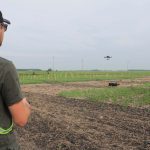
Editor’s column: Here’s to Prairie ag innovators

New approach to in-bin grain drying
Digital tool can take some of the worry out of harvesting tough grain

High-tech weed control to give farmers a look into how precise spraying can be
Digital tool can be used to predict where weeds will emerge and identify areas with herbicide resistance within fields

Market expert urges cautious approach for forward grain selling

New tool for anthracnose control in lentils
Zetigo PRM targets disease with a novel mode of action and helps farmers manage fungicide resistance

AUDIO: How weather could shape your grain marketing options in 2023

Prairie insect pest outlook for 2023
Grasshoppers top the threat list but flea beetles, wheat midge, lygus bug, cutworms, bertha army worm and wheat stem sawfly are also risks in some areas

How to control crown rust in oats
In severe cases, it can slash yields by up to 40 per cent. Here are four strategies to help keep that from happening

Cover cropping on the Prairies
A farmer survey shows many producers are growing cover crops successfully, but more agronomic knowledge and supports are needed

Tools to reach 52 bushels per acre canola in 2023
Focus on and execute these five agronomy priorities to increase overall yields and profitability


